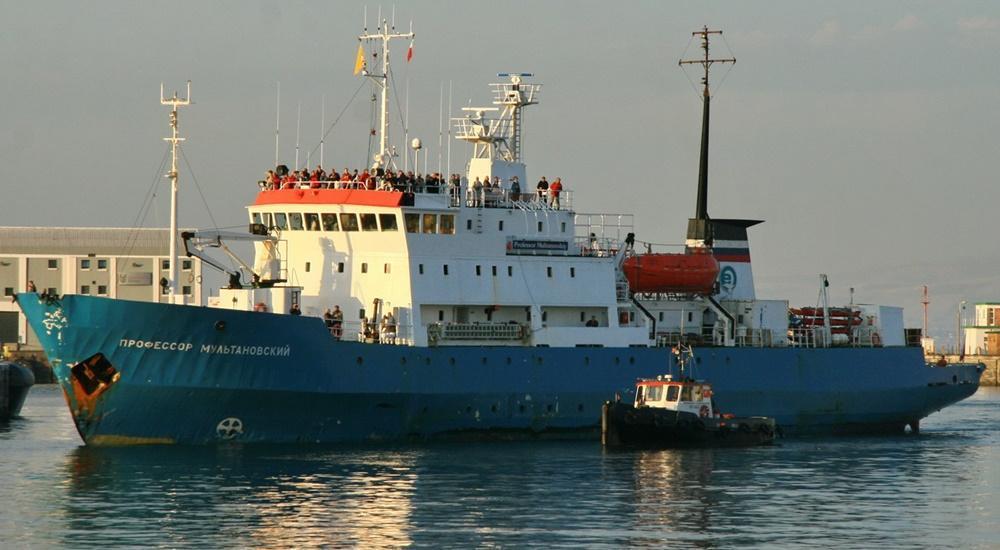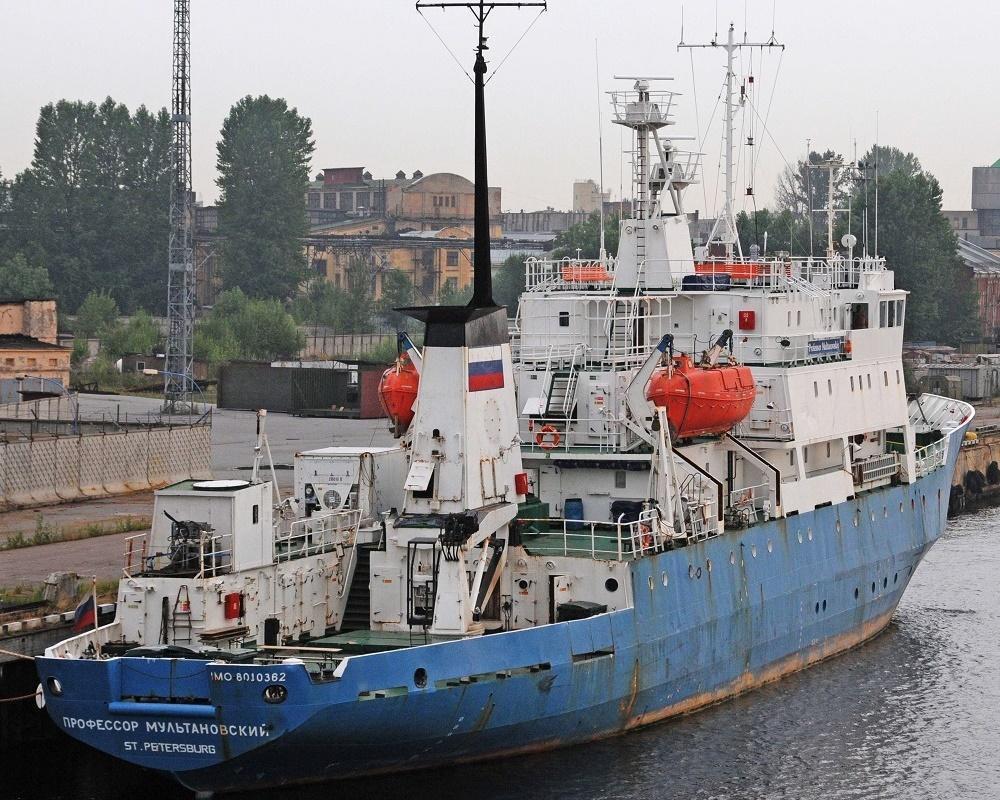Professor Multanovskiy
Professor Multanovskiy current position
The current location of Professor Multanovskiy is in East Asia (coordinates 43.10493 N / 131.92558 E) cruising en route to VLADIVOSTOK. The AIS position was last reported 2 minutes ago.
Current PositionSpecifications of Professor Multanovskiy
| Year of build | 1983 / Age: 42 |
| Flag state | Russia |
| Builder | Oy Laivateollisuus AB (Turku, Finland) |
| Class | ice-strengthened expedition ship |
| Ferry route / homeports | Vladivostok |
| Speed | 14 kn / 26 km/h / 16 mph |
| Length (LOA) | 71 m / 233 ft |
| Beam (width) | 13 m / 43 ft |
| Gross Tonnage | 1753 gt |
| Passengers | 49 |
| Crew | 44 |
| Decks | 6 |
| Cabins | 29 |
| Decks with cabins | 3 |
| Sister-ships | Professor Molchanov, Professor Khromov (Spirit of Enderby), Akademik Shuleykin (Polar Pioneer), Akademik Shokalskiy |
| Owner | Russian Federation (via Gidrometflot) |
| Operator | Heritage Expeditions New Zealand (via FERHRI-Far Eastern Regional Hydrometeorological Research Institute) |
Professor Multanovskiy Review
Review of Professor Multanovskiy
The 1983-built MV Professor Multanovskiy ("Профессор Мультановский") is a polar expedition cruise ship owned by Gidrometflot Russia (Hydrometeorological Fleet, Vladivostok, Russia) and managed by Russia's Far Eastern Regional Hydrometeorological Research Institute (Дальневосточный региональный научно-исследовательский гидрометеорологический институт / ФГБУ ДВНИГМИ).
The vessel (IMO number 8010362) is currently Russia-flagged (MMSI 273432910) and registered/homeported in Vladivostok.
The ship is seasonally chartered by polar cruise companies and small tour operators, like Oceanwide Expeditions, Ocean Adventures, Ewaterways, 50+ Expeditions.

One of the Arctic expedition ships, MS Multanovskiy is a Russian ice-strengthened oceanographic research vessel also operated as a cruise ship. The vessel was built in Finland for the Soviet Union (USSR) in 1983. Today, it is converted to a passenger shipping vessel in order to serve the small ship expedition cruising market.
Launched on May 25, 1983, this ship is named after the Russian meteorologist Boris Pompeevich Multanovsky (Борис Помпеевич Мультановский, 1876-1938). MS Multanovskiy cruise itinerary program offers Arctic and Antarctic expedition voyages.
Laivateollisuus Oy was a shipbuilding company (Turku Finland-based shipyard) that operated between 1944-1988. In 1983, the shipbuilder was acquired by Valmet Marine, which in 1987 became part of Wartsila - just to be closed down in 1988. The Laivateollisuus company built various types of marine vessels, including schooners (a total of ninety 3-masted wooden schooners). In its peak, the shipbuilding yard was Turku's 3rd-largest (following Valmet and Crichton-Vulcan) with around 750 employees.
Professor Multanovskiy is one of the Laivateollisuus-built research ships of the USSR's Akademik Shuleykin-class (Project 637). The vessel (Turku shipyard/hull number 346) is powered by two marine diesel engines (model 6ChRN 36/45 ) with combined power output 2,3 MW. The propulsion system is single-shaft, with one CPP/controllable-pitch propeller.
The polar-class expedition ship Multanovskiy was originally used as an oceanographic research vessel. Following the 1996 major drydock reconstruction and refurbishment, the boat started operations on the Russia-sponsored Arctic and Antarctic research missions and also on privately chartered polar cruise itineraries. From the same Akademik Shuleykin-class are also the research ships (converted and now operated as cruise vessels) Akademik Shuleykin (1982, now Polar Pioneer), Akademik Shokalskiy (1982), Professor Molchanov (1982) and Professor Khromov (1984, fka Spirit of Enderby).
Decks and Cabins
For cruise passengers, MS Multanovskiy staterooms (26 total) include 1x Suite (Amundsen Suite, room 513 on Deck 5), 2x Superior cabins (rooms 510-517), 12x double cabins with en-suite bathrooms (411, 413, 415, 418, 420, 421, 425, 426, 505, 509, 518, 521), 9x double cabins with shared bathrooms (311, 314, 315, 321, 322, 326, 327, 331, 332), 2x Triple cabins with common baths (312-313) plus 3 staff cabins (309-310-337, for tour guides / expedition staff).
All passenger cabins are cleaned daily. Towels are changed only upon request. Bedsheets are changed every 3rd day. Room service (food or drink) is not available. Laundry service is provided at an additional cost (per item) by the cabin staff via forms and bags (available in each cabin). The laundry collection is in the morning. Ironing services are also available at extra charge. The ship has no self-serve laundry room and dry-cleaning.
Electrical outlets (power sockets) are European standard Plug Type C (2 round pins). The windows in all cruise cabins (square window and portholes) are opening. The cabin's temperature control is adjustable (regulates the flow of warm air from a vent). In the cabins and throughout the ship, the average temperature is 21-24 C (70-75 F).
- Amundsen Suite is sized 270 ft2 (25 m2) and has en-suite bathroom.
- Superior Cabins are sized 190-225 ft2 (18-21 m2) and have en-suite bathrooms.
- Twin Cabins are sized 100-125 ft2 (9-12 m2) and are in two types - with Private Facilities (en-suite bathroom) and with Shared Toilets (common baths).
- Triple Cabins are with Shared Toilets and sized 110-120 ft2 (10-11 m2).
The boat has 6 decks, of which 5 are passenger-accessible and 3 with cabins.
Professor Multanovskiy ship details
Main shipboard facilities include a small Library (polar and reference books, playing cards and board games), Infirmary (medical clinic), Sauna (5 people, complimentary, open daily, self-use basis, not supervised), bar lounge, 2 restaurants (buffet-style dining rooms with table service). The dining room doubles as a lecture room. The ship has open-air viewing areas (bow and stern open decks and at the Wheelhouse/Navigation Bridge). The ship's open-bridge policy allows passengers to visit the Wheelhouse at any time (excluding during bad weather).

All onboard announcements are in English and via the boat's PA (public address) system. Announcements include wildlife sightings, disembarkation instructions, itinerary information, weather updates. The cruise company's Expedition Leader and staff provide regular updates and info on zodiac landings, as well as a lecture series (with media presentations) and documentary films. In the evening, the daily program for the next day (lectures, dining hours, scheduled activities) is distributed to all passenger cabins.
The bar lounge is bartender-served. Wine and champagne (by the glass) are offered in the dining room and at the bar. The ship's Hotel Manager supervises all passenger services (including the onboard accounts), supervises the waiting staff (international) and the crew (Russians).
The ship has Zodiac craft for wildlife viewing, shoreside cruising and landings. Like all polar cruise ships, MS Multanovskiy has an ice-strengthened hull designed for safe navigation in ice-packed waterways. The ship doesn't have Jacuzzi (hot tub), swimming pool, elevator, helipad (helicopter deck). Vessel details include:
- Max Draught: 4,5 m (15 ft)
- DWT Deadweight tonnage: 2113 tons
- Displacement tonnage: 10000 tons
- Operational Range: 3560 km (2210 mi)
- Max Speed 14 knots (16 mph / 26 kph)
The Zodiacs are RIB boats (rigid inflatable boats) powered by 4-stroke outboard motors that give good speed and maneuverability.
Note: In the case of poor AIS coverage, tracking the vessel's current location will be impossible. You can see the CruiseMapper's list of all icebreakers and ice-breaking research ships in the "itinerary" section of our Icebreakers hub. All states and their fleets are listed there.
Other Small Cruise Lines cruise ships
Professor Multanovskiy Wiki
In 2019 (July-September) the ship Multanovskiy participated in the "Trans Arctic 2019" research expedition in Russia's Far East. During the voyage, Russian scientists studied the country's Arctic waterways. For these studies, the Government allocated ~RUB 870 million (~USD 13 million). The cruise itinerary started from Vladivostok and via Bering Strait to Kola Peninsula. The voyage was planned in 4 stages and also included the Russian research vessels Mikhail Somov (IMO 7518202) and Akademik Tryoshnikov (IMO 9548536).

